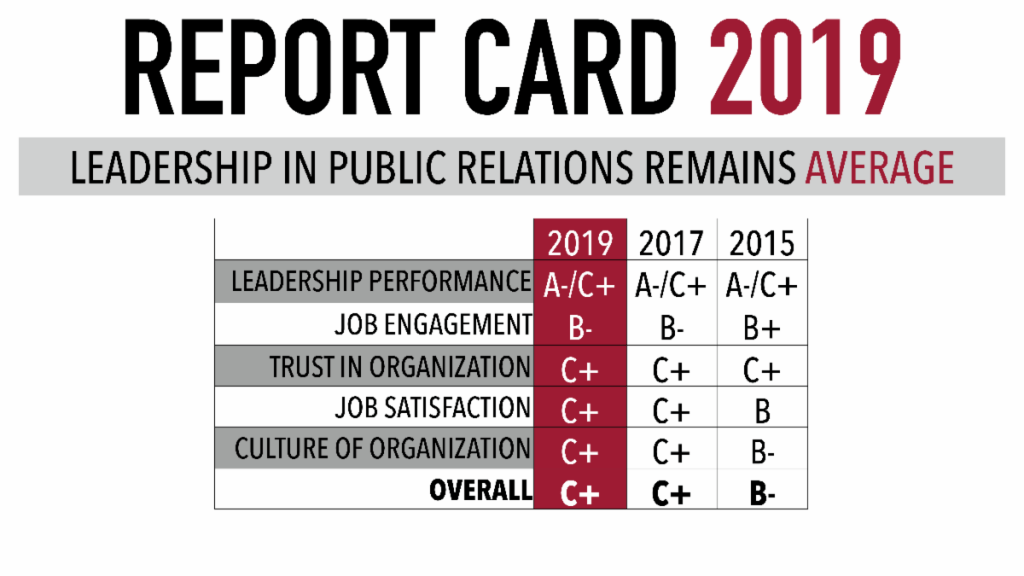PR Leaders Receive “C+” on 2019 Report Card
Published on December 10, 2019, at 2:00 p.m.
by Justine Groeber.
The Plank Center for Leadership in Public Relations recently released its 2019 Report Card on PR Leaders, a biennial study that surveys PR professionals on five categories: leadership performance, job satisfaction, organizational trust, organizational culture and job engagement.
The third installment of this research series surveyed over 800 public relations professionals, and the results were less than impressive. In fact, the results showed that leadership in PR remains pretty average with a letter grade of a “C+,” indicating no definite improvement from years past.

While the profession’s overall letter grade reflected no change, previously reported gaps, specifically those between men’s and women’s perceptions of the workplace and practice and between the perceptions of leaders and others in the organizations, deepened further. Jessika White, communications specialist for the Plank Center, indicated that these findings are a “huge wake-up call for the profession.”
With little hope for future growth, many PR professionals are asking, what has led to the lack of improvement for leaders in the profession?
One of the most cited barriers to improvement is the ego of our leaders — some already assume they are doing a great job and believe the findings don’t apply to them. Dr. Bruce Berger, professor emeritus at The University of Alabama’s College of Communication and Information Sciences, stated, “There’s no reason for them to worry about leadership development or performance personally because they are already great.”
In a PR Daily article, Berger speculated some PR leaders are “highly self-reflective” and “think consciously about their interactions with the people who work for them and how they come across as a leader. Other leaders I know don’t have an ounce of self-reflection, and they don’t really care how others might see them.” While there are leaders who are not open to criticism, Berger emphasized that a leader must be willing to change.
While Berger cites several possible reasons for the apparent stalling of the PR profession, he believes perhaps the most important one is “we need the profession, in all of its dimensions, to announce leadership development as a strategic priority and collectively try to battle it.” In order to fight this issue, Berger specifically mentioned implementing leadership classes into PR curriculum, dedicating columns in trade publications to leadership development and tactics and having PRSA and other PR groups embrace the challenge.
Similarly, White emphasized the importance of every PR professional, despite their leadership level, being aware of these findings. “The mid-level managers, the young professionals, students should be reading this as well — just because your leader might not be taking this to heart, doesn’t mean that this shouldn’t be on your radar.” She continued, “You can lead from where you are; you don’t need to have a CCO title.”

Another important finding of this year’s report card is the percentage of disengaged professionals and leaders, especially among women. While the job engagement letter grade remains at a “B-” from the 2017 report card, nearly one in 12 professionals surveyed is disengaged. Even more concerning is the slow increase in actively disengaged leaders and women in the profession. The percentage of disengaged leaders increased from 3.2% to 5.8% since 2015. Meanwhile, the rate of disengaged women nearly doubled from 5.1% in 2015 to 9.6% in 2019.
The actions of an actively disengaged employee can have harmful effects on an organization due to these individuals adversely influencing their colleagues. With this potential outcome in mind, White highlighted the importance of evaluating internal aspects. “It’s crucial for organizations to read this report, let it sink in and begin an organization reflection process,” she explained. “Organizations could perform an internal audit to see how they stack up against the report card. Clearly, gaps exist — as the research shows — but we need leaders to step up to bridge those gaps.”
The significant gap between leaders’ perceptions of themselves (A-) and the perceptions their employees have of them (C+) also remains unsurprising. “Most everyone in any type of role will evaluate themselves a little bit higher than others around them would,” Berger stated in the PR Daily article. While this gap doesn’t come as a surprise, the significant discrepancy should come as a concern to public relations leaders.
The increase in the gender gap from 2017 to 2019 is apparent in every subject area and should be closely monitored. The report noted, “Women said they want more involvement in strategic decision making, they want their opinions to count for more, and they want a communication system that places greater emphasis on two-way communication.” Similar to the leadership performance gap between leaders and their employees, men and women see their organization’s diversity efforts differently; these gaps will not disappear without action from every level of an organization.
While the findings of the 2019 Report Card may paint a less-than-perfect picture for the industry, Berger does not believe the profession is “doomed to mediocrity forever.” He has hope in the next generation of leaders, believing that “they are better educated, more inclusive, diverse and more concerned about things like this.”

The positive change in PR leadership can undoubtedly start in the classroom. The University of Alabama has one of two leadership courses in public relations programs in the U.S. The coursework was created by Berger in 2015 and touches upon elements that are vital to leadership. White stated, “We hope other institutions will consider adopting this course into their curriculums.”




